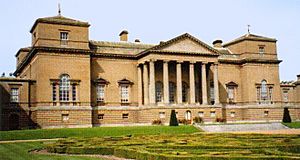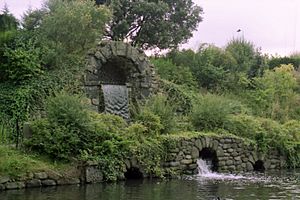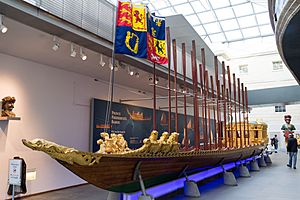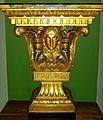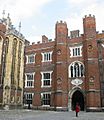William Kent facts for kids
Quick facts for kids
William Kent
|
|
|---|---|
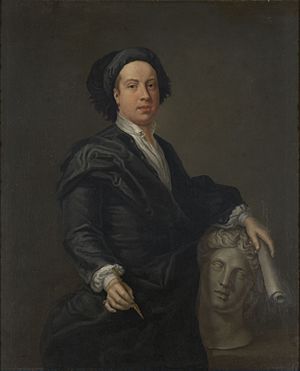
Portrait by William Aikman, c. 1710–1720
|
|
| Born | late 1685 Bridlington, East Riding of Yorkshire, England
|
| Died | 12 April 1748 (aged 62) Burlington House, London, England
|
| Nationality | English |
| Occupation | Architect |
| Buildings | Holkham Hall Chiswick House 44 Berkeley Square Badminton House Stowe House |
| Projects | Palladian style English landscape garden |
William Kent (around 1685 – 12 April 1748) was a very talented English artist and designer. He lived in the early 1700s. He was known for being an architect (someone who designs buildings), a landscape architect (someone who designs gardens and outdoor spaces), a painter, and even a furniture designer.
Kent started his career as a painter. He even became the official painter for the King or Queen! But his true skill was in designing many different things. He helped bring a building style called the Palladian style to England. This style was inspired by ancient Roman and Greek buildings. He also created a new, "natural" way of designing gardens, which became known as the English landscape garden. You can still see his garden designs at places like Chiswick House and Stowe Gardens.
Besides buildings and gardens, Kent also designed fancy furniture. He made pieces for important places like Hampton Court Palace and Chiswick House.
Contents
Early Life and Artistic Journey
William Kent was born in Bridlington, a town in England. He was baptized on January 1, 1686.
Kent began his career painting signs and coaches. People saw his talent and encouraged him to study art and design. A group of people from Yorkshire helped him go to Rome, Italy, to study. He arrived in Italy in late 1709.
While in Rome, he won an award for his painting. He also met important people, including Richard Boyle, 3rd Earl of Burlington, who became a very important supporter of Kent's work. Kent painted a ceiling in a church in Rome. He left Rome in 1719 and returned to England with Lord Burlington. In England, he helped decorate grand palaces and houses, including Kensington Palace and Chiswick House.
Designing Buildings: The Palladian Style
Kent started designing buildings a bit later in his life, in the 1730s. He is famous for bringing the Palladian style of architecture back to England. This style uses ideas from the Roman architect Andrea Palladio.
Lord Burlington helped Kent get important jobs designing public buildings in London. These included the Royal Mews (where royal horses were kept) and the Treasury buildings in Whitehall. He also designed the Horse Guards building, which was built after he died. These buildings looked like ancient Roman buildings.
Kent also designed many country houses. One of his most complete Palladian designs is Holkham Hall in Norfolk. Here, he worked with another architect, Thomas Coke.
Kent could also design buildings in a Gothic style when needed. He worked on Gothic screens in Westminster Hall and Gloucester Cathedral.
Creating Natural Gardens
As a landscape designer, Kent was one of the first to create the English landscape garden. This was a "natural" style of gardening that changed how gardens and large estates were planned. Instead of formal, straight lines, these gardens looked more like natural landscapes.
His garden projects included Chiswick House and Stowe, Buckinghamshire. He also designed gardens for Alexander Pope and Queen Caroline. A very famous garden he designed is at Rousham House in Oxfordshire. Here, he created beautiful scenes with temples, waterfalls, caves, and bridges. This style paved the way for even larger gardens designed by Capability Brown later on.
Some people said Kent didn't know much about plants or how to grow them. But his natural style of design was a huge contribution to garden history. Places like Claremont, Stowe, and Rousham show his amazing work.
Designing Furniture and Other Items
Kent's furniture designs were grand and matched the interiors of the buildings he designed. He made furniture for Hampton Court Palace, Chiswick House, and Holkham Hall.
He even designed a royal boat for Frederick, Prince of Wales. You can see this beautiful boat at the National Maritime Museum in Greenwich.
William Kent was so famous that people asked him to design all sorts of things. Sometimes, he even designed ladies' dresses! This led to some jokes and cartoons by other artists, like William Hogarth.
William Kent's Legacy
Horace Walpole, a famous writer, described Kent as a great innovator. He said Kent was a good architect and the "father of modern gardening." Walpole believed Kent created an art that made paintings come to life and improved nature itself.
List of Works
Domestic Buildings and Interiors
- Kensington Palace, fresco on grand staircase
- Wanstead House, interior decoration (1721–24)
- Burlington House, London, interior decoration (c.1727)
- Chiswick House, London, interiors and furniture (c.1726–29)
- Houghton Hall, interiors and furniture (c.1726–31)
- Ditchley, Oxfordshire, interiors (c.1726)
- Sherborne House, Gloucestershire, furniture designs (1728)
- Stowe House, interiors and garden buildings (c.1730 to 1748)
- Alexander Pope's Villa, designs for garden buildings (c.1730)
- Richmond Gardens, garden buildings 1730–35
- Stanwick Park, remodelled and interiors (c.1730–40)
- Raynham Hall, interiors and furniture (c.1731)
- Kew House (1731–35)
- Esher Place, the wings (c.1733)
- Shotover House, Obelisk, Octagonal & Gothic temples (1733)
- Holkham Hall, with Earl of Burlington & Earl of Leicester (1734–1765)
- Devonshire House including furniture (1734–35)
- Easton Neston, designed fireplaces (1735)
- Aske Hall, Gothic temple (1735)
- Claremont Garden, garden buildings (1738)
- Rousham House, addition of wings and landscaping of the gardens & garden buildings (1738–41)
- Badminton House, remodelling of the north front, interiors (c.1746–1748)
- Worcester Lodge at Badminton House (1746)
- 22 Arlington Street, London (1741–50)
- 44 Berkeley Square, London (1742–44)
- 16 St. James Place, London (early 1740s)
- Oatlands Palace, garden building (c.1745)
- Euston Hall, Suffolk (1746)
- Wakefield Lodge, Northamptonshire (c.1748–50)
Public Buildings and Royal Commissions
- Chiesa di San Giuliano dei Fiamminghi, painted ceiling (c.1717)
- York Minster, marble pavement (1731–35)
- Royal Mews (1731–33)
- Royal State Barge (1732)
- Hampton Court Palace, gateway in Clock Court & rooms for the Duke of Cumberland (1732)
- Kensington Palace, interiors, including Cupola Room and several murals and painted ceilings (1733–35)
- Former Treasury building Whitehall (1733–37)
- St James's Palace, the library (1736–37)
- Westminster Hall, Gothic screen enclosing law courts (1738–39)
- York Minster, Gothic pulpit and choir furniture (1741)
- Gloucester Cathedral, Gothic choir-screen (1741)
- Horse Guards (1750–59)
Church Memorials
- Chester Cathedral, to John & Thomas Wainwright
- Henry VII Lady Chapel, to George Monck, 1st Duke of Albemarle (1730)
- York Minster, to Thomas Watson Wentworth (1731)
- Westminster Abbey to Sir Isaac Newton, sculpted by John Michael Rysbrack (1731)
- Kirkthorpe church, to Thomas & Catherine Stringer (1731–32)
- Blenheim Palace Chapel, to John Churchill, 1st Duke of Marlborough, sculpted by John Michael Rysbrack (1733)
- Westminster Abbey, to James Stanhope, 1st Earl Stanhope (1733)
- Westminster Abbey, to William Shakespeare, sculpted by Peter Scheemakers (1740)
- Ashby-de-la-Zouch, to Theophilus Hastings, 9th Earl of Huntingdon (1746)
Images for kids
See also
 In Spanish: William Kent para niños
In Spanish: William Kent para niños


